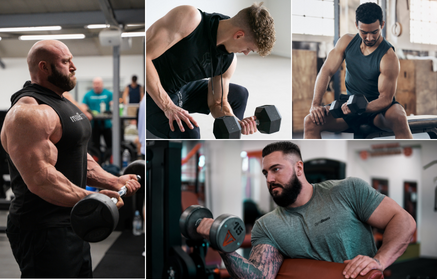Table of Contents
Bulky biceps is the dream of many gym goers. It looks just great whether you’re wearing a tank top or a tight t-shirt, and there’s probably no other muscle that is so often put on display by athletes. A strong bicep sends a simple message: you work on your body. However, you don’t have to spend day in and out doing the same exact exercises. It’s always better to choose quality over quantity, and take good advice when it comes to working on these muscles in a complex way.
How to train your biceps?
The biceps brachii is a large, thick muscle on the ventral portion of the upper arm. It consists of two heads – a short (caput breve) and a long head (caput longum). Its main function is flexion and supination (outward rotation) of the forearm. This means you use it all the time, whether you’re lifting your shaker full of your favourite protein drink or a fork with a delicious cake. [1]
When working on your biceps, the same rules as when working on any other muscle group apply. Always make sure that you’ve warmed up properly to prepare your muscles for the strain. A good way to start is a several low intensity sets with a low weight. You certainly don’t want to rip your bicep up by reaching straight for the heaviest dumbbell that you find lying around in the gym. If doing a bicep curl with a heavy weight makes you twist around like you’re on a dance floor, it probably means you should lower your load. Before anything else, focus on mastering the proper technique of the exercise and only then take the step towards the heavier dumbbells.
The exercises presented in this article will help you build a gym training routine for your bicep. To begin, simply pick two to three of these exercises, and perform three sets within the 8 to 12 rep range. The overall load should correspond to about 60 to 75% of your 1RM (the maximum amount of weight that a person can possibly lift for one rep). Your bicep training can be done on its own, or combined with other muscles such as triceps, ideally two to three times a week. Keep in mind that full regeneration of any muscle group typically takes up between 24 and 72 hours. Considering this, always take the regeneration period into account when planning out your weekly training routine and rep ranges for each specific muscle group that you are working on. [2–4]

8 most effective bicep exercises
There is no shortage of exercises for biceps available. In today’s article, we will present the most effective ones out there. To perform these, you will only need the regular equipment widely available in every gym such as an adjustable bench, a short or EZ bar, dumbbells and gym pulley systems. Which of these you ultimately choose to incorporate into your training routines is all up to you. Some exercises offer alternatives and modifications. In addition, you can modify the grip width, allowing you to target biceps under various angles. Finally, using an overhand grip will add further challenge to your forearms.
1. Barbell Biceps Curl
- Starting position: Stand with your feet hip-width apart and grasp the barbell with an underhand grip at about the width of your shoulders. Make sure you stand up straight with your knees slightly bent and hold the barbell by your hips with your arms outstretched.
- Execution: Bend your elbows and raise the bar towards your shoulders with an outbreath, contracting your biceps. You can hold it in the upper position for 1–2 seconds. Inhaling, return the barbell to the initial position in a controlled manner. Continue with the next repetition.
- Frequent mistakes: Engaging the lower limbs, elbows pointing away from the body, bending of the wrists, bending lower back, uncontrolled movement, insufficient range of motion, inappropriately chosen load.

Other modifications of the exercise:
1. EZ Bar Biceps Curl
The regular barbell can be substituted by the curved EZ bar, which offers several choices in terms of the grip.
2. Powerbag Biceps Curl
You can also try this exercise using a powerbag or water powerbag. Simply grasp it by the upper handles and use it the same way you would use a barbell.
3. Plate Biceps Curl
This exercise can also be performed using a large weight plate. Grasp it by its sides and pull it towards your chest. However, this variation is a less comfortable one.
You might be interested in these products:
2. Reverse Grip Barbell Biceps Curl
- Starting position: Stand with your feet hip-width apart and grasp the barbell at the width of your shoulders using a reverse grip (palms facing down). Make sure you stand up straight with your knees slightly bent and hold the barbell by your hips with your arms outstretched.
- Execution: Bend your elbows and raise the bar towards your shoulders with an outbreath, contracting your biceps. You can hold it in the upper position for 1–2 seconds. Inhaling, return the barbell to the initial position in a controlled manner. Continue with the next repetition.
- Frequent mistakes: Engaging the lower limbs, elbows pointing away from the body, bending wrists, bending lower back, uncontrolled movement, insufficient range of motion, inappropriately chosen load.
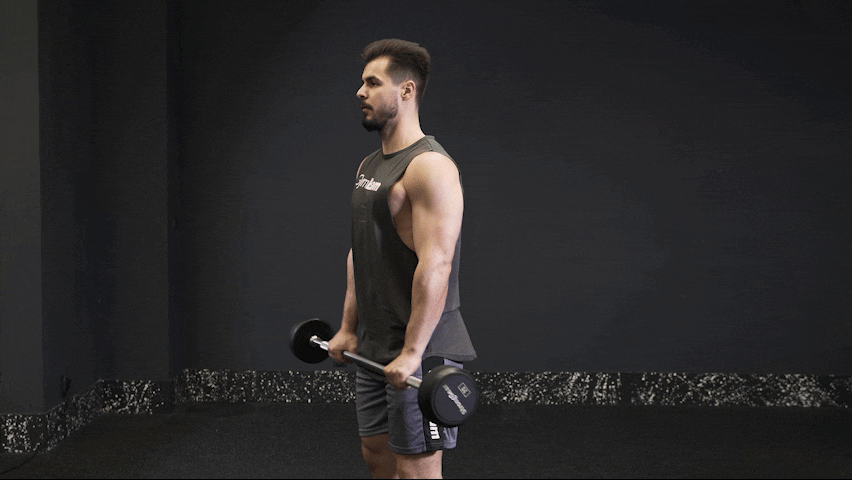
Other modifications of the exercise:
1. Reverse Grip EZ Bar Biceps Curl
The regular barbell can be substituted by the EZ bar, which offers several grip choices.
2. Reverse Grip Powerbag Biceps Curl
You can also try this exercise using a powerbag or water powerbag. Simply grasp it with a reverse grip by the upper handles and use it the same way you would use a barbell.
3. Alternating Dumbbell Biceps Curl
- Starting position: Stand with your feet hip-width apart and grasp one dumbbell with each hand. Make sure you stand up straight with your knees slightly bent. Leave your arms outstretched along the body with your palms facing your hips.
- Execution: With an outbreath, begin raising one arm towards the same shoulder, contracting the biceps. In the bottom position, smoothly turn the palm upwards. In the upper position, you can hold it for 1–2 seconds. Inhale and return your arm to the starting position and repeat with the other arm.
- Frequent mistakes: Engaging the lower limbs, elbows pointing away from the body, bending wrists, bending lower back, uncontrolled movement, insufficient range of motion, inappropriately chosen load.

Other modifications of the exercise:
1. Alternating Kettlebell Biceps Curl
In a modification of this exercise, the dumbbells can be substituted with kettlebells. Simply grasp the kettlebell by the handle with an underhand grip and use it the same way you would use a dumbbell. If you only have a single kettlebell available, first perform the whole series with one arm and then the other.
2. Scott Bench Dumbbell Biceps Curl
This exercise may also be performed on the Scott Bench. Grasp one dumbbell, sit down facing the bench, lean your chest against it and place one upper arm on the bench. You can also lean with your other hand for better stability. The starting position is with straight elbows. As you exhale, raise the arm with the dumbbell to your shoulder, hold the contraction for 1–2 seconds, then return to the starting position. After completing the set, switch hands.
4. Alternating Dumbbell Hammer Biceps Curl
- Starting position: Stand with your feet hip-width apart and grasp one dumbbell with each hand. Make sure you stand up straight with your knees slightly bent. Leave your arms outstretched along the body with your palms facing your hips.
- Execution: With an outbreath, begin raising one arm towards the same shoulder, contracting the biceps. Palms keep facing your sides. In the top position, you can hold it for 1–2 seconds. Inhale and return your arm to the starting position and repeat with the other arm.
- Frequent mistakes: Engaging the lower limbs, elbows pointing away from the body, bending lower back, uncontrolled movement, insufficient range of movement, inappropriately chosen load.
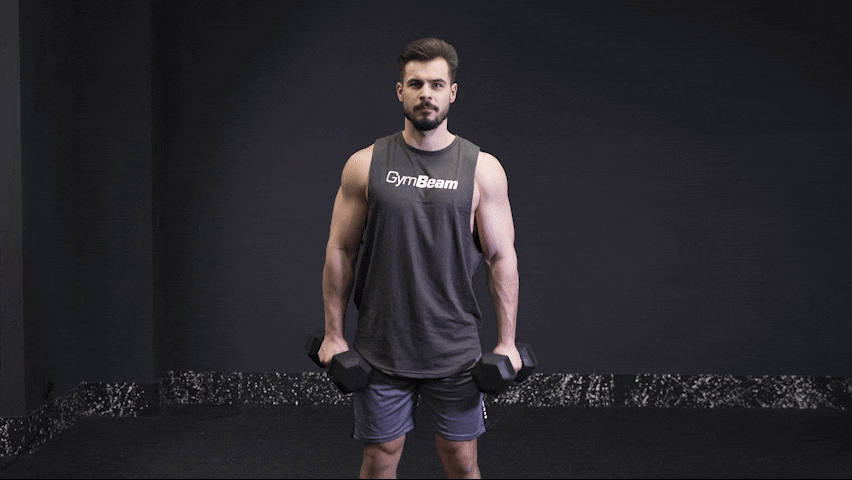
Other modifications of the exercise:
4. Dumbbell Hammer Biceps Curl
You may also lift both of your dumbbells at the same time, which is somewhat more challenging. In this case, pay extra attention to proper technique. It is also advisable to choose smaller weights.
5. Dumbbell Incline Bench Biceps Curl
- Starting position: Sit on an incline bench adjusted to the angle of 45 to 60 degrees. Grasp your dumbbells with an underhand grip and lean your entire back and head on the bench. Keep your arms tense alongside your body. Bend your knees and place your feet firmly on the ground.
- Execution: With an outbreath, raise both dumbbells towards your shoulders, contracting the biceps. Palms are facing upwards. In the upper position, you can hold it for 1–2 seconds. Inhale and return your arms and dumbbells to the starting position and repeat.
- Common mistakes: Bending lower back, bending wrist, uncontrolled movement, insufficient range of motion, inappropriately chosen load.
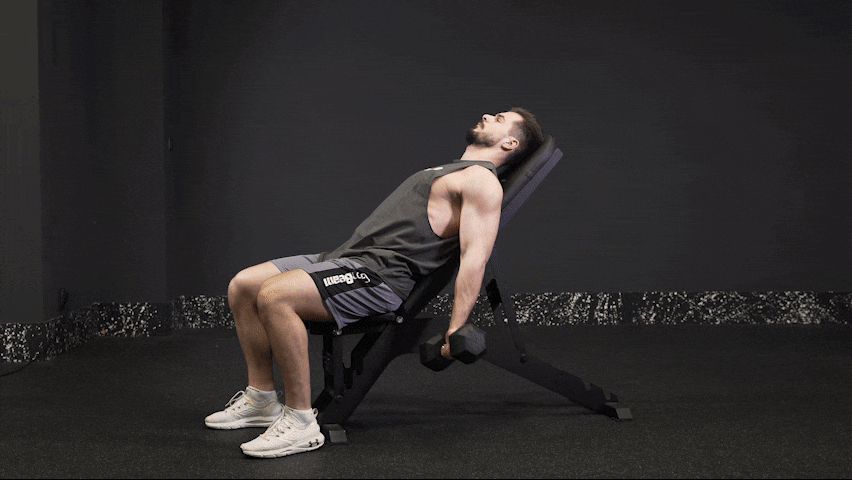
Other modifications of the exercise:
1. Alternating Dumbbell Incline Bench Biceps Curl
You can also lift the dumbbells in an alternating manner. This way, you can pay more attention to the movement of each arm, which will help you focus on proper technique and bicep contraction.
2. Kettlebell Incline Bench Biceps Curl
The same exercise can be done with kettlebells. If you only have a single kettlebell available, first perform the whole set with one arm and then the other.
6. One Arm Concentration Curl
- Starting position: Sit on a straight bench with your knees bent and feet on the floor. Grasp a dumbbell with one hand, lean forward with a straight back and rest your elbow on the inside of the knee of the same side leg. Lean and support yourself on the other leg using the other palm.
- Execution: With an outbreath, begin raising one arm towards the same shoulder, contracting the biceps. In the upper position, you can hold it for 1–2 seconds. Inhale and return your arm to the starting position and then repeat. Once you finish your set, perform another with the other arm.
- Frequent errors: Lack of control in the movement, bending the wrist, insufficient range of motion, inappropriately selected load.
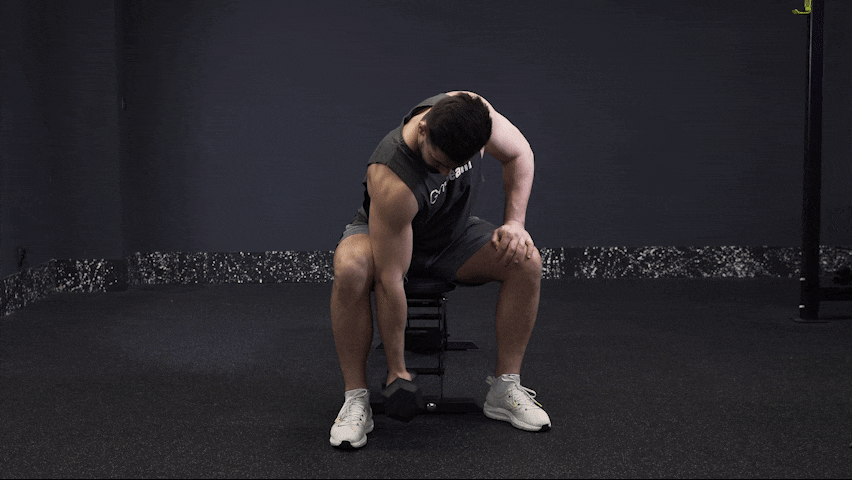
Other modifications of the exercise:
1. Kettlebell One Arm Concentration Curl
In a modification of this exercise, the dumbbell can be substituted with a kettlebell. Simply grasp the kettlebell by the handle with an underhand grip and use it the same way you would use a dumbbell.
7. Cable Biceps Curls
- Starting position: Stand with your feet hip-width apart, facing the pulley machine. Grasp the straight bar attachment attached to the low position of the pulley approximately at the width of your shoulders. Stand up straight with your knees slightly bent.
- Execution: With an outbreath, raise the adapter bar to your shoulders, contracting the biceps. Keep your elbows at your sides. In the upper position, you can hold it for 1–2 seconds. Inhale and return to the starting position. Follow with another repetition.
- Frequent mistakes: Bending lower back, uncontrolled movement, insufficient range of motion, wrist bending, inappropriately chosen load.

Other modifications of the exercise:
1. One Arm Cable Biceps Curl
Using a D-handle will allow you to perform this exercise with a single arm at a time. This way you can pay more attention to the proper technique and muscle engagement.
8. Cable Crossover Biceps Curl
- Starting position: Stand sideways in between two opposing pulley machines. Grasp one D-handle on each side attached to the top-mounted pulley. The arms are stretched and the knees are slightly bent.
- Execution: With an outbreath, pull the adapters towards your shoulders, contracting the biceps. Keep the elbows at the same height. In the upper position, you can hold it for 1–2 seconds. Inhale and return the adapters to the starting position. Follow with another repetition.
- Frequent mistakes: Engaging the lower limbs, bending the back, bending the wrists, uncontrolled movement, insufficient range of movement, inappropriately chosen load.
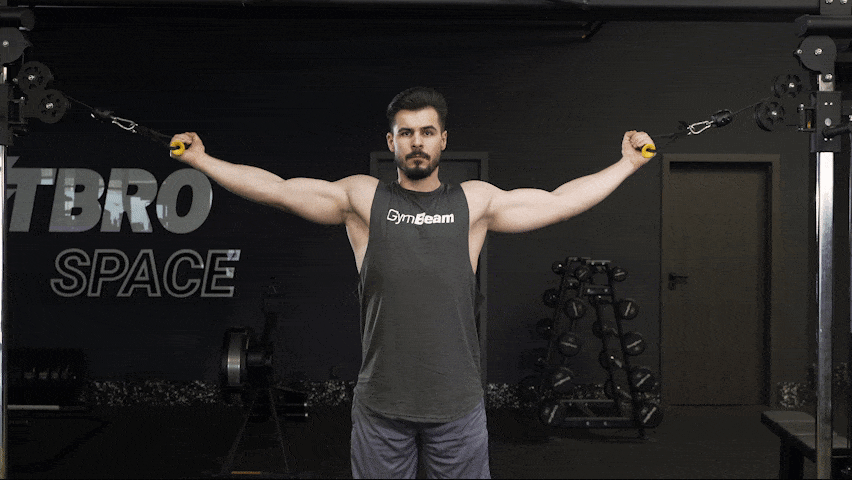
Other modifications of the exercise:
1. Upper Cable Biceps Curl
This exercise can be performed with just one arm at the time so that you can pay more attention to the proper technique and muscle engagement.
What’s next?
- Would you like to know how to pick the appropriate weight for you? Learn more about the topic in our article How Much Weight to Lift for Muscle Growth, Strength or Weight Loss?
- If you’re looking for further effective exercises to develop all of your arm muscles, don’t forget about your triceps. Here are the 10 Best Triceps Exercises.
- If you are wondering how to determine the ideal repetition range according to your goals, don’t miss out on our article How Many Reps Should You Do to Lose Weight or Gain Muscle?
- If your goal is to gain muscle mass, don’t miss out on our article What to Eat and How to Exercise to Finally Gain Muscle?
- Trying to gain some muscle mass without success? Don’t miss out on our article 10 Tips for Healthy Weight Gain.
- Want to calculate your ideal macronutrient intake levels according to your goals? Our Online Energy and Macronutrient Intake Calculator will help you do just that.
What should you remember?
Whether you’re looking to grow large biceps or simply want to acquire a stronger and more toned upper body, your training routine should include some basic exercises. Try bicep curls with dumbbells, kettlebells, pulley or barbell. In your training routine, you can use a variety of modifications, which will help you effectively work on both heads of the bicep. Always focus on proper technique first. Make sure you feel your muscles engage right, and add the load slowly and steadily. Make bicep exercises part of your workout routine two to three times a week. When planning this, keep in mind that your body needs proper time for recovery.
Did you find this article helpful? If so, share it with your friends and help them get inspired in their bicep training routine too.
[1] Physiopedia. Biceps Brachii. – https://www.physio-pedia.com/Biceps_Brachii
[2] Burd, N. A., West, D. W. D., Moore, D. R., Atherton, P. J., Staples, A. W., Prior, T., Tang, J. E., Rennie, M. J., Baker, S. K., & Phillips, S. M. . Enhanced Amino Acid Sensitivity of Myofibrillar Protein Synthesis Persists for up to 24 h after Resistance Exercise in Young Men. – https://doi.org/10.3945/jn.110.135038
[3] Krzysztofik, M., Wil k, M., Wojdała, G., & Gołaś, A. Maximizing Muscle Hypertrophy: A Systematic Review of Advanced Resistance Training Techniques and Methods.– https://doi.org/10.3390/ijerph16244897
[4] Schoenfeld, B. J., Grgic, J., Van Every, D. W., & Plotkin, D. L. Loading Recommendations for Muscle Strength, Hypertrophy, and Local Endurance: A Re-Examination of the Repetition Continuum.– https://doi.org/10.3390/sports9020032

